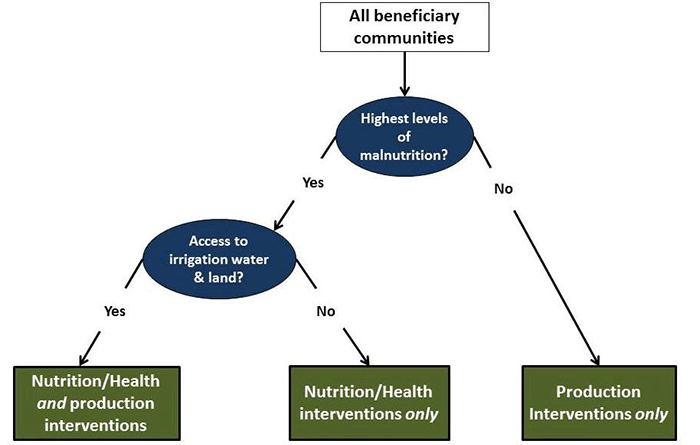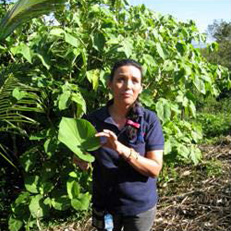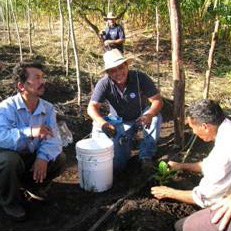Field Note Highlights
This Field Note focuses on:
- How ACCESO hires, trains, and supports technicians
- How technicians carry out their work
- What kind of technical assistance beneficiaries receive
- How training and technical assis-tance are provided
- How nutrition and agricultural pro-duction technicians work together to integrate their activities toward a common goal
Despite worldwide efforts to reach the Millennium Development Goal target of halving the proportion of people who suffer from hunger by 2015, 165 million children remain stunted and 870 million people are chronically undernourished. The 2013 Lancet Series on Maternal and Child Nutrition points to a growing consensus that combating the global burden of malnutrition will require collaboration across development sectors.
Recognizing the potential gains that can be made through better coordination, USAID’s Bureau for Food Security and Bureau of Global Health commissioned the Strengthening Partnerships, Results, and Innovations in Nutrition Globally (SPRING) project to lead a series of practical and program-driven Agriculture and Nutrition Global Learning and Evidence Exchange (AgN-GLEE) events in Uganda, Guatemala, and Thailand between December 2012 and March 2013.
To inform the agendas of the AgN-GLEEs, SPRING conducted a landscape analysis. Its purpose was to review and synthesize current Feed the Future investments being made by USAID, extracting key data and patterns from project documents and telephone interviews with USAID Missions. In addition to completing landscape analysis reports for each of the 19 Feed the Future countries, SPRING also conducted several field studies. These qualitative exercises were designed to gather, analyze, and summarize one or more practical activities being carried out by either a USAID Mission or a Feed the Future implementing partner that demonstrated potential for supporting nutritional outcomes within the country’s Feed the Future defined zone of influence.
This field note highlights the ACCESO project in Honduras, which had shown promising reductions in underweight after only 18 months of implementation. Designed to integrate agriculture and nutrition interventions to achieve nutrition results, ACCESO relies on having field-based technical staff working together across the agriculture and nutrition sectors. In February 2013, SPRING project staff conducted a weeklong field visit in the departments of Santa Barbara and Lempira. The visit included interviews with ACCESO staff and project beneficiaries, as well as site visits to farms, training sessions, women’s meetings, cooking demonstrations, and community centers. Information collected was analyzed using the conceptual pathways between agriculture and nutrition1 to identify ways in which ACCESO is linking agricultural interventions with nutritional outcomes.
Activity Accomplishments as of December 2012
After 18 months of implementation, ACCESO documented a number of accomplishments, including:
- Held 23,391 training events, reaching 25,248 individuals (including 8,270 women).
- Realized a 24 percent decrease in underweight children among beneficiary households, from 22 percent to 16.7 percent versus baseline.
- Operationalized nine fully equipped nutrition training centers.
- Realized maize yields six times higher than departmental averages and nearly three times higher than national averages.
- Established 902 family plots used mostly for family consumption, growing a range of nutritious foods
Background
ACCESO is a USAID-funded four-year integrated agriculture and nutrition project that started in April 2011. Implemented by Fintrac Inc., the project aims to:
- Bring 30,000 rural households out of poverty
- Generate $73.95 million in net profits
- Create 10,425 permanent jobs by February 2015
ACCESO plans to achieve this by providing technical assistance and capacity building to smallholder farmers in targeted highland communities to improve agricultural production, post-harvest processing and storage, business and marketing skills, off-farm income-generating opportunities, and access to markets by helping eliminate policy barriers. These agriculture production activities are coupled with targeted nutrition interventions to improve health and consumption behaviors and prevent malnutrition.
The project works in six Western Highland departments of Honduras. The main value chains targeted by the activity include coffee, horticulture, maize, and beans; support is also provided where appropriate with livestock, value-added processed food items and selected off-farm business opportunities. Some communities receive only agricultural production interventions, while others receive only nutrition and health interventions. Still others receive a mixture of all types of interventions. Communities receiving health and nutrition interventions, or “prioritized communities,” were selected because they have the highest malnutrition rates in national surveys. Often, beneficiaries in prioritized communities receiving only health and nutrition interventions have no access to land or water for irrigation.
Within target communities, only households that are interested and willing to adopt project practices receive project interventions. Households with pregnant women and children under two years old are the primary beneficiaries of nutrition activities. ACCESO’s poverty reduction activity targets include its 30,000 families, while nutrition activities target the entire population in the six departments. Figure 1 illustrates the community selection process.
The project has more than 105 agricultural production technicians, an average of 17 per department, and 15 nutrition and health technicians, or two to three per department. They are assisted by 434 nutrition volunteers who received training under the government Atención Integral a la Niñez en la Comunidad (AIN-C) program, which lost funding in 2012. Each production technician meets 300 to 350 households weekly for group trainings and demonstrations within their designated zones. Despite their low numbers, the nutrition and health technicians are responsible for working with all beneficiaries in prioritized communities and provide training and support to AIN-C volunteers. They do not have as structured a workload as production technicians, as each pair is responsible for reaching an entire department.
Figure 1. The community selection process

Pathways Linking Agriculture and Nutrition
Global evidence has led to the development of a theoretical framework that presents seven key pathways linking agriculture and nutrition (Annex 1). SPRING used this framework to assist in analyzing ACCESO’s training, extension and behavior change approach. The Income → Food Purchase pathway is the primary goal of the ACCESO project. The Own Production → Food Consumption pathway is also a primary guide for ACCESO’s targeted agriculture extension and nutrition education work. Also, the Women’s Control of Income → Resource Allocation. Women’s Time Use → Care Capacity and Women’s Workload → Maternal Energy Use pathways are touched upon, but are not a primary focus of the project objectives or the aim of most technician trainings. Each primary and secondary pathway serves as a basis for the analysis below.
Primary Pathways
Income → Food Purchase: ACCESO’s primary goal is to increase the income of vulnerable beneficiary households by increasing on-farm income and diversifying to off-farm opportunities. ACCESO technicians provide weekly trainings to smallholder farmers that highlight improved growing techniques of staple and higher-value horticultural crops for sale. Other trainings focus on small business creation, management, finance, and other topics that can increase income among beneficiary households. These hands-on trainings are held on beneficiary farms with groups of farmers and are reinforced by regular contact between the farmers and technicians. In communities where both nutrition and economic development activities are provided, some trainings focus on ensuring that increased incomes translate into sustainable positive changes in household, community, and overall nutrition indicators by promoting relevant messages to encourage specific behaviors. Project staff assist beneficiaries in making small-scale investments for household improvements (for preventing health/nutrition problems), provide education on associated behavioral changes (dietary, feeding practices, hygiene, etc.) and involve the entire family in the process to facilitate the translation of increased income into improved nutrition.
Own Production → Food Consumption: Improvements in production practices and diversification of crops are often assumed to lead to better nutrition when families consume more of what they produce. ACCESO nutrition technicians work primarily with women on family plots to grow local, nutritious crops and teach about the nutritional value of each item, as well as how to prepare and serve the foods to their young children and themselves. Monthly group cooking demonstrations are held in community centers and family homes for all mothers with children under two years of age. All women with children under two are encouraged to bring food from home to prepare diverse and nutritious meals. Follow-up household visits are made to families with underweight children to address any barriers. The project supports the consumption of animal source food, mainly through demonstrations and training to manage poultry, which are commonly owned by project beneficiaries. Where families own cows, technical assistance is provided to increase daily milk production for consumption, sale, and small-scale processing.

ACCESO nutrition education
Secondary Pathways
Women’s Control of Income → Resource Allocation: Due to labor demands, time constraints, and traditional roles, women are generally not the direct managers of family farming operations or farm income. In response, ACCESO promotes off-farm job opportunities for women, including the creation of small businesses such as tailoring and bakeries. The project provides business, leadership, and management trainings to women, as well as support in obtaining legal documentation, which are common barriers in Honduras.
Women’s Time Use → Care Capacity and Women’s Workload → Maternal Energy Use: ACCESO staff are aware that increasing income opportunities for women and promoting family plots grown by women could negatively impact family nutrition outcomes, as women’s time investment in income generation may take away from the time they have for caregiving. This extra work may also have negative consequences during pregnancy for the woman and her unborn child. ACCESO staff note the off-farm opportunities are not intended to create full-time jobs, but rather to constitute one piece of the poverty-reduction strategy for these households. Also, home improvements such as more efficient stoves, translucent roofing that allows natural lighting, improved floors and walls, and household access to clean water are improving family health and decreasing the time that women spend on daily activities. Beneficiaries in communities prioritized to receive nutrition and health interventions provide labor and contribute to the purchase of these improvements, which are generally affordable even for vulnerable households. Nutrition technicians provide training and work alongside beneficiaries to carry out the needed work.
Training Philosophy and Approaches
In developing a training program to provide capacity strengthening and ongoing education to project technicians and beneficiaries, ACCESO has relied on a number of concepts that underpin the project philosophy. First, the project embraces the notion of continuous learning. Trainings and demonstrations for beneficiaries and project technicians reinforce messages multiple times in an effort to succeed in changing behavior. Second, trainings involve interactive capacity strengthening. The ACCESO design and implementation team believes it is crucial to enter homes and provide regular, hands-on capacity strengthening to the same beneficiaries, with no graduation during the project cycle. Finally, the project seeks to work with motivated beneficiaries. Beneficiaries are targeted based on willingness to adopt new behaviors and invest their time and resources.

ACCESO agriculture training
Training of Project Technicians
- An initial three-week “boot-camp” training was held in April 2011 for all project technicians. It included training on such topics as production techniques, postharvest processes, market access, and nutrition behaviors.
- Subsequent hires have not received this thorough training, but instead receive ongoing individualized on- and off-site training from their supervisors.
- All technicians receive a packet of basic nutrition messages to share with households; only nutrition technicians receive detailed nutrition training.
- Monthly in-service trainings are held in relevant agricultural, environmental, nutrition, and hygiene topics that have been identified by supervisors or subject experts.
- Senior agriculture and nutrition technicians develop materials used to train technicians and beneficiaries.
- Nutrition training materials are adapted from Ministry of Health guidelines.
- Agriculture training materials are designed locally by project technicians and subject experts. Also, a textbook providing guidance on production techniques and crop manuals for a wide range of crops is available to technicians for reference.
- ACCESO provides AIN-C volunteers with training and materials and prioritizes these volunteers as recipients of household improvements as incentives to participate. They also receive technical assistance to encourage income generation activities.
Participant Training and Support
- Beneficiary farmers are encouraged to form groups of 10 to 20 farmers, who receive weekly visits from agricultural technicians. During these visits the farmers are provided with hands-on training on a wide range of topics in agricultural production, postharvest handling, and marketing, with selected messages also provided in health and nutrition.
- Nutrition and health trainings are coupled with household improvements, cooking demonstrations, and monthly child growth monitoring and promotion in prioritized communities for households with pregnant women and children under two.
- AIN-C volunteers and ACCESO nutrition technicians provide one-on-one counseling during monthly growth monitoring home visits to caregivers with children under two who are underweight.
Figure 2. ACCESO trainings

Conclusion
ACCESO has an innovative, integrated design that has led to initial successes in decreasing malnutrition and increasing incomes. Project activities fit predominantly within the Income → Food Purchase and Production→ Consumption pathways through a variety of agricultural and economic training programs that encourage production of diverse, nutritious crops and help lift vulnerable families out of poverty. To reach project goals, these pathways must work in a complementary way. To that end, the project recognizes the value of shared training and regular communications among project staff. ACCESO staff explained that the focus on regular, continuous training of beneficiaries and technicians is crucial to building trust and achieving sustainable behavior change. However, due to the supervisor-driven nature of the technician trainings, project success hinges on maintaining a core of highly educated, dynamic leaders who design and lead trainings (based on beneficiary demand and needs as perceived by project staff) for junior technicians and beneficiaries.
A more balanced set of investments and interventions could help ACCESO to more successfully incorporate intermediate steps along the pathways between agriculture and nutrition and achieve measurable and sustainable nutrition outcomes. At the time of the field visit, the project had seven times more production technicians than nutrition technicians. This unequal investment is unlikely to support long-term outcomes for improved nutrition in the target area. ACCESO is not unique within the Feed the Future initiative in that it had to retrofit its design to address nutrition. Continued use of the pathways between agriculture and nutrition may assist in providing clarity on realistic nutrition outcomes that may be accomplished through this agriculture and economic growth-centered project. Although it is unclear whether ACCESO will be able to affect nutritional status across the five targeted departments, the trainings being used and promoted under the project may have a measurable impact on the project’s 30,000 direct beneficiary families. Indicators reflecting intermediate steps along the targeted pathways could signal the extent to which current project activities may in fact be leading to improved nutritional status among the populations that they reach.
Future Research Questions
This brief field note was based on initial desk research, interviews with donors and project staff and one site visit by SPRING research staff. As with any field research, the visit raised additional areas of inquiry that are of interest. Some of the potential research questions may already be part of the Mission or project’s learning agenda. For ACCESO, the following are some of the research questions that warrant additional consideration:
- When funding for nutrition-specific activities is limited, what are the most important design components that should be used to obtain measureable and sustainable outcomes? How might the pathways between agriculture and nutrition be helpful in informing these design components?
- What activities within integrated agriculture/nutrition projects like ACCESO are most likely to generate sustainable outcomes beyond the funding cycle?
- What indicators along the pathways between agriculture and nutrition being used in ACCESO would assist the implementing partner in better managing activities to support nutrition outcomes?